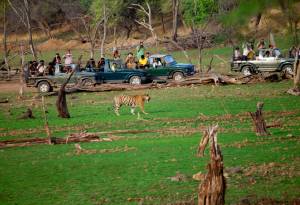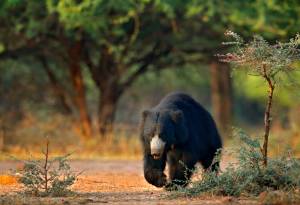Overview
The jungle safari at Ranthambore National Park happens twice a day, every day, between the months of October and June and is a popular tourist attraction in Rajasthan. The wildlife safari is only permitted during the months of October-June and is not available on Wednesdays, as the park remains closed. Bookings for the Ranthambore safaris are handled by the Forest Department and are offered in two formats: Jeep Safari and Canter Safari. The Jeep Safari can accommodate up to 6 people, while the Canter Safari can hold up to 20 people at a time.
Although the Ranthambore’s Jeep Safari is slightly more expensive than the Canter, it is recommended by visitors who have experienced the wildlife of the park because it allows for more flexibility in movement and can access areas the Canter cannot.
The Safari lasts approximately 3 and a half hours and occurs twice a day: once in the morning and once in the evening. Since these safaris are very popular, it’s advisable to book well in advance. The park also reserves a certain number of seats every morning for slots in the evening of that day and the following morning. You can book the seats for your safari online.
A Brief Insight into Ranthambore Tiger Reserve
Ranthambore National Park is among the foremost tiger reserves in the world that shelters the Bengal Tiger species. It is a favorite destination for photographers and wildlife enthusiasts. Located in Sawai Madhopur, in the northern Indian state of Rajasthan, Ranthambore Tiger Reserve has emerged as a renowned destination for wildlife tourism in India. Uniquely, the tigers here are active during the day, unlike most tigers that are typically nocturnal.
Given the substantial number of tigers that roam freely within the park, there’s a good chance of spotting one during a visit. These majestic creatures exist nonchalantly in the reserve, so if you’re keen on a close encounter, allowing you to observe them in all their grandeur, then a jungle safari is the way to go. Ranthambore National Park offers safaris for visitors eager to see the tigers in their natural habitat. In addition to the tigers, one might also encounter other wildlife such as leopards, hyenas, wild cats, reptiles, and a variety of birds that call Ranthambore home.
Need assistance with Ranthambore Safari bookings? Call or WhatsApp at +91-9212777225.
Best of Ranthambore’s Safari Zones
Ranthambore National Park is divided into ‘core areas’ and ‘buffer zones’. The ‘core areas’ are regions where tigers roam freely. To protect and support their habitat, deforestation and other commercial activities are prohibited in these areas. In contrast, ‘buffer zones’ are areas of the reserve where the land can be used by local people for farming or other purposes while still being managed for conservation by the government.
For visitor convenience, Ranthambore National Park is segmented into 10 zones for tiger sightings. Zones 1-5 constitute the core areas, while zones 6-10 are part of the buffer zone. Zones 3, 4, and 5 are particularly popular and preferred by many visitors. During the summer, tigers are more easily sighted in these zones due to the presence of lakes and other water bodies. These sites attract tigers and other animals looking to quench their thirst in the hot season.
Wildlife That Can Be Spotted During Ranthambore Jungle Safari
Being a tiger reserve, Ranthambore National Park has a large number of Tigers in its habitat. It also has other big cats such as-
- Leopard
- Caracal
- Jungle Cat
- Fishing Cat
Apart from the wild cats, the park has other wild animals as well, such as:
- Desert Fox
- Indian Fox
- Indian Wild Boar
- Palm Civet
- Hanuman Langurs
- Sambar Deer
- Spotted Deer
- Indian Gazelle
- Black Buck
- Blue Bull or Nilgai
Ranthambore also has abundant reptile species as well, like:
- Desert Monitor Lizards
- Banded Kraits
- Cobras
- Tortoise
- Indian Pythons
- Indian Flap Shelled Turtle
- Russell’s Viper
- Snub Nosed Marsh Crocodiles
The bird enthusiasts can indulge in a wholesome bird watching experience due to the variety of birds that are found here. Some of them include:
- Woodpeckers
- Greylag Goose
- Asian Palm Swift
- Dove
- Crakes
- Sandpipers
- Flamingos
- Pelicans
- Storks
- Bulbul
- Mynas
- Falcons
- Parakeets
- Cuckoos
- Owl
- Nightjars
Ranthambore Safari Timings
Safari timings in the Ranthambore tiger reserve vary by season, so it’s best to confirm them before your visit-
| Month | Morning Safari | Afternoon Safari |
| 1st Oct to 31st Oct | 06.30 am – 10.00 am | 02.30 pm – 06.00 pm |
| 1st Nov to 31st Jan | 07.00 am – 10.30 am | 02.00 pm to 05.30 pm |
| 1st Feb to 31st march | 06.30 am – 10.00 am | 02.30 pm to 06.00 pm |
| 1st April to 15th May | 06.00 am – 09.30 am | 03.00 pm to 06.30 pm |
| 16th May to 30th June | 06.00 am – 09.30 am | 03.30 pm to 07.00 pm |
Best Time for Ranthambore’s Jungle Safari
The best time to visit Ranthambore National Park is during the months of October to March since the weather is pleasant to travel. But it is during the months of April to June that you can see tigers more since they can be seen near the lakes and other water bodies to quench their thirst during the hot summer season.
- Advance Booking: Ensure you book your Ranthambore safari well in advance. Due to its popularity, failing to do so might result in not getting your preferred zone, vehicle, or even a seat.
- Multiple Safaris: Consider taking multiple safaris. This increases your chances of sighting a tiger, as sightings are influenced by both seasons and tiger movements.
- Hydration: Bring plenty of water. A safari typically lasts around 3 and a half hours.
- Binoculars: Given that animals might be distant, carrying binoculars can enhance your viewing experience.
- Clothing: Opt for earthy-toned clothes like brown, green, and beige. These help you blend in with the surroundings. Avoid bright colors like red, which might make animals cautious and deter them from approaching.
Dos and Don’ts During the Safari
- Protection: Carry sun hats, scarfs, and masks. The park’s climate is dry, and there can be considerable dust.
- Behavior: Stay composed and calm. Always listen to your guide.
- Feeding: Never feed the animals. They have ample food, and feeding them can be dangerous given their wild nature.
- Littering: Avoid littering during your safari. Instead, dispose of waste at designated spots.
- Vehicle Safety: Do not disembark from your vehicle and always remain seated.
- Noise: Refrain from making loud noises or sounds. This could deter animals and hinder sightings.
- Substances: Smoking and alcohol consumption are prohibited within the park’s premises.

 +91- 9212777225
+91- 9212777225


























 +91-8744012007
+91-8744012007 Plan Your trip
Plan Your trip